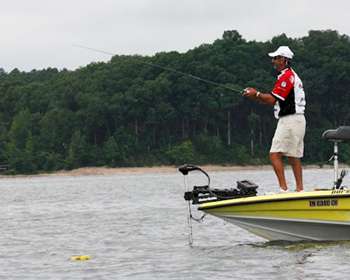
To the untrained eye, deep structure fishing may appear to be little more than flinging a bait into open water and hoping for a bite. However, deep-cranking expert and Elite Series pro Paul Elias has spent decades refining deep structure fishing, and he knows there's an exact science to taking advantage of a structure bite.
One key piece of equipment that Elias always carries with him — and one you shouldn't be without — is a marker buoy. The BASS heavyweight record holder has a few tips when it comes to utilizing marker buoys. When fishing offshore structure, Elias always has a marker buoy on the front deck, ready for deployment with a swift kick. As soon has he hooks up, Elias knocks the marker buoy overboard, marking his location when the strike occurred.
While the buoy gives Elias a solid point of reference, he also pays close attention to the location of the bass on the end of his line. "One key thing I always do is look at my line when I have a fish on," Elias explains. "When it starts coming toward the surface, I find a point on the bank directly behind the hooked bass. That allows me to instantly create a line of reference with two points so I know exactly where that bass came from."
With a marker buoy and a point on the bank, Elias can repeat the successful cast without wasting time searching for the productive piece of structure. "If that bass came off one stump or one rock, it allows me to be able to make that exact same cast again and find the structure quickly," says Elias.
The phrase "close only counts in horseshoes" applies to deep structure fishing as well. The ability to duplicate a precise cast can be the difference between a frustrating day and a boatload of bass. "I can remember when I caught over 60 pounds of bass off one rock on Lake Guntersville," recounts Elias. "In order to get bit, I had to cast from a certain angle 10 or 12 times in a row and then I'd catch a 5-pounder. It's really important that once you find the best angle, you can repeat that cast." For Elias, duplicating casts not only ensures that his bait is around the fish but, more importantly, that his bait is hitting the structure.
During the 2008 Elite Series slugfest at Falcon Lake, where Elias won with over 132 pounds of largemouth, the key to the quality bite came down to creating a deflection with his Mann's crankbait. "At Falcon, there were certain features on the bottom, and I had to hit that certain spot with my bait or else the bigger bass wouldn't react at all," he explains.
While many anglers idle over a piece of structure and drop a marker buoy directly on top of it, Elias tries to avoid driving over the structure if conditions allow. "I usually just have one marker buoy right by the boat, two if it's really windy," he explains. "I usually try to avoid running over my fish before I cast to them, so that's why I'll use the buoy to mark where my boat needs to be sitting to reach the target."




